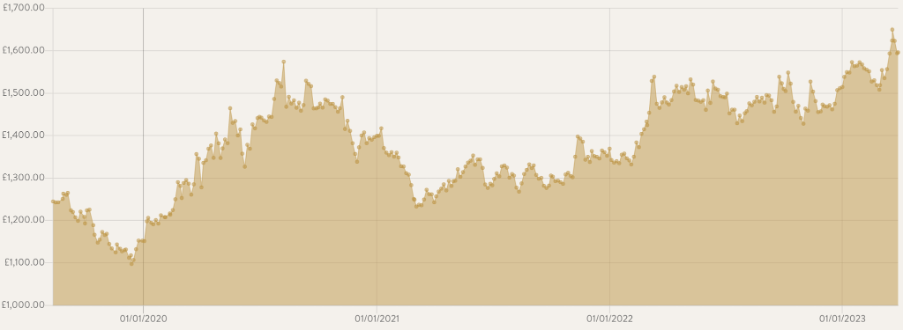Nine gold mining shares that could add sparkle to your ISA
29th March 2023 12:49
by Ben Hobson from interactive investor
It’s a speculative sector, but one that can unearth some real nuggets, especially when inflation is high. Stock screen expert Ben Hobson finds shares with solid earnings records and attractive dividend profiles.

With double-digit inflation proving hard to tame, gold mining shares could be an interesting option for investors looking for exposure to a classic inflation hedge, plus some eye-catching dividend yields to boot.
Last year, events in the equity and bond markets conspired to leave many onlookers speechless. With rising inflation, higher rates and the threat of recession, shares inevitably slumped. If you believe the theory, bonds should have stepped in to soften that blow and protect portfolios - but they slumped too.
- Invest with ii: Share Dealing with ii | Open a Stocks & Shares ISA | Our Investment Accounts
Another asset that is popular for its protection against inflation is gold. But again, depending on who you were (and more importantly what currency you were buying in) gold didn’t prove to be the hedge that some might have hoped for, either.
But let’s explore this for a moment. Take a look at the gold chart and it appears that the price is currently trading close to a multi-year high. So, what’s the problem?

Chart: Royal Mint. Past performance is not a guide to future performance.
The answer is that gold is conventionally priced in US dollars. And with the dollar proving to be so strong through much of last year, gold in dollar-terms was fairly muted. But if you were a gold buyer in British pounds, or even euros, it produced a much better return.
For example, if you had bought gold in US dollars at the start of 2022, you’d be looking at a gain of around 9.1%, much of which has been achieved in the early months of 2023. But if you had bought in British pounds, your return would have been a much healthier 19.3%. Given the experience of equity markets last year, that feels like a hedge that paid off.
How to think about gold mining shares
As an investor, there are a few ways of getting exposure to gold. One is to buy coins or bars directly. For less hassle, you can buy ‘paper’ derivatives (or ETFs) that give you ownership without having to store and secure the metal. Alternatively you can buy shares in gold mining companies.
All three have their pros and cons but it’s worth remembering that gold itself doesn’t generate a return - it’s simply a store of value. So generating a return from physical gold (or even a paper derivative) means buying and then selling it (at a higher price). With gold mining companies, you can get exposure to the gold price plus any dividends paid.
This naturally raises the question of whether shares in gold miners behave like the gold itself or like regular shares. In other words, how much gold price exposure are you really getting with these shares?
On this, the academic research is tantalising but comes with caveats. A study of performance between 2006 and 2015 by Mark Johnson and Doug Lamdin found that the return on gold mining shares is explained more by the return on gold than by the return on shares. So that certainly indicates that they tend to move with the gold price.
However, the gold price itself isn’t correlated with the stock market, as you might expect. And given that there are many other factors that move share prices, owning gold mining shares is a riskier way of getting exposure to the gold price.
On balance then, this feels like an area of the market where stock selection is all-important. So I have applied a minimum market cap rule of £50 million focusing on the gold, precious metals and mining sectors and looked at some basic growth, quality, valuation and momentum measures.
Name | Market cap (£m) | EPS 5y %chg | Operating Margin (%) | ROCE (%) | Forecast PE Ratio | Forecast Yield (%) | Chg since 1y high (%) |
234.8 | 580 | 52.9 | 30.8 | 5 | 7.2 | -21.3 | |
4,660.20 | 197.5 | 25.7 | 9.8 | 18.1 | 3.6 | -6.65 | |
17,625.50 | 77.1 | 47.8 | 7.9 | 39.1 | 1.3 | -3 | |
218.4 | 74.5 | 32.8 | 22.8 | 12 | 3.5 | -8.56 | |
308.2 | 34.5 | 27.9 | 26.4 | 5 | 5 | -33.3 | |
400.8 | 30 | 22.1 | 11.8 | 23.8 | 4.6 | -45.8 | |
209.6 | -16.7 | 40.4 | 15.9 | 3.2 | 4.3 | -8.97 | |
5,298.30 | -46.2 | 11.7 | 5.8 | 29.8 | 1.9 | -25.6 | |
1,163.40 | -76.3 | 21 | 12.7 | 12.5 | 3.2 | -18.7 |
This table is sorted based on the five-year change in earnings-per-share. Sylvania Platinum Ltd (LSE:SLP) easily leads on that measure, followed by its much larger peers, Endeavour Mining (LSE:EDV) and Wheaton Precious Metals (LSE:WPM). Sylvania also has the highest forecast dividend yield at 7.2% and is among the cheapest with a single-figure forecast P/E of just 5x.
Note that on earnings, Gemfields Group Ltd (LSE:GEM), Fresnillo (LSE:FRES) and Centamin (LSE:CEY) all have negative growth over five years. This shows how important it is to look carefully and understand the earnings history and performance of any mining business.
Encouragingly, and fairly typically for precious metals miners, the operating margins are generally strong, but again there are differences which could hint at some companies being more efficient than others.
- 10 cheap growth shares for bullish investors
- 10 UK shares Warren Buffett might put in his ISA in 2023
Rising costs over the past year, especially in energy, has affected many miners, so profitability measures like margins and returns on capital employed (ROCE) are worth watching closely. Note that Sylvania, Caledonia Mining Corp (LSE:CMCL) and Pan African Resources (LSE:PAF) have significantly higher ROCEs than the others.
In terms of yield, there are encouraging signs here, and so there should be given the strong gold price. Sylvania, Pan African, Hochschild Mining (LSE:HOC) and Gemfields are all on yields above the market average (of about 3.8% for the FTSE 100). And in terms of momentum, it’s a mixed bag, with the larger shares close to 52-week highs but the smaller stocks considerably lower.
Going for gold…
Making sense of the international gold market and all of its competing influences is a tough call for investors. Understanding global demand and the intricacies of mining in far off territories will always make this quite a speculative part of the market. It’s part of the reason why many trade at relatively cheap earnings multiples.
But there is no denying the appeal and the idea that gold can have a diversifying role, especially when inflation is running high. Some shares in this sector have got solid earnings records and attractive dividend profiles, which means they could add some much-needed sparkle to a portfolio.
Ben Hobson is a freelance contributor and not a direct employee of interactive investor.
These articles are provided for information purposes only. Occasionally, an opinion about whether to buy or sell a specific investment may be provided by third parties. The content is not intended to be a personal recommendation to buy or sell any financial instrument or product, or to adopt any investment strategy as it is not provided based on an assessment of your investing knowledge and experience, your financial situation or your investment objectives. The value of your investments, and the income derived from them, may go down as well as up. You may not get back all the money that you invest. The investments referred to in this article may not be suitable for all investors, and if in doubt, an investor should seek advice from a qualified investment adviser.
Full performance can be found on the company or index summary page on the interactive investor website. Simply click on the company's or index name highlighted in the article.
Disclosure
We use a combination of fundamental and technical analysis in forming our view as to the valuation and prospects of an investment. Where relevant we have set out those particular matters we think are important in the above article, but further detail can be found here.
Please note that our article on this investment should not be considered to be a regular publication.
Details of all recommendations issued by ii during the previous 12-month period can be found here.
ii adheres to a strict code of conduct. Contributors may hold shares or have other interests in companies included in these portfolios, which could create a conflict of interests. Contributors intending to write about any financial instruments in which they have an interest are required to disclose such interest to ii and in the article itself. ii will at all times consider whether such interest impairs the objectivity of the recommendation.
In addition, individuals involved in the production of investment articles are subject to a personal account dealing restriction, which prevents them from placing a transaction in the specified instrument(s) for a period before and for five working days after such publication. This is to avoid personal interests conflicting with the interests of the recipients of those investment articles.
Please remember, investment value can go up or down and you could get back less than you invest. If you’re in any doubt about the suitability of a stocks & shares ISA, you should seek independent financial advice. The tax treatment of this product depends on your individual circumstances and may change in future. If you are uncertain about the tax treatment of the product you should contact HMRC or seek independent tax advice.